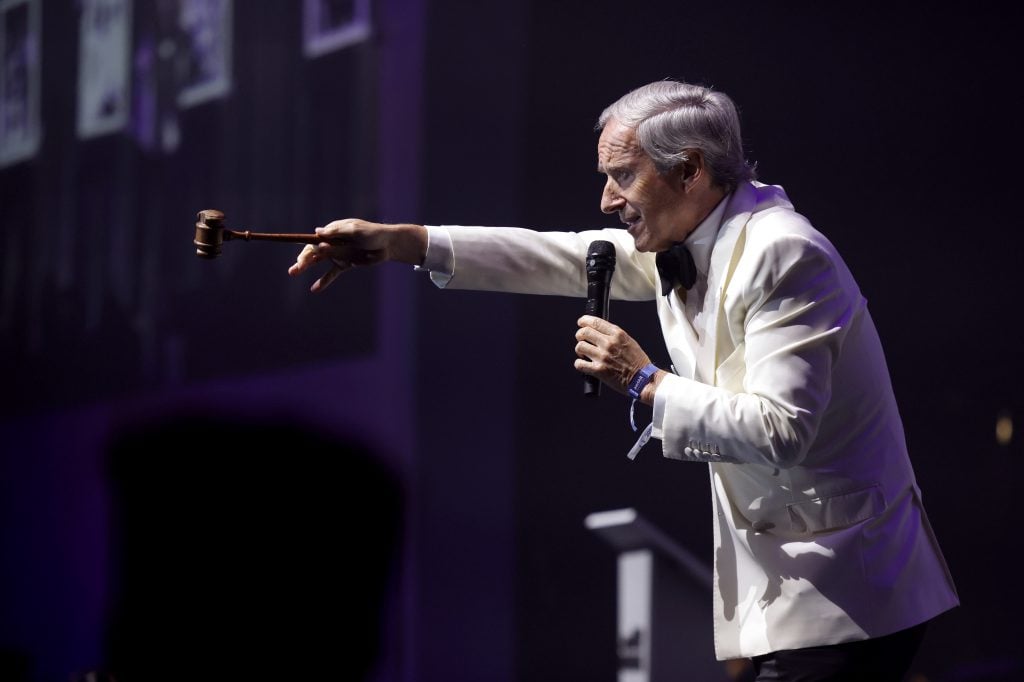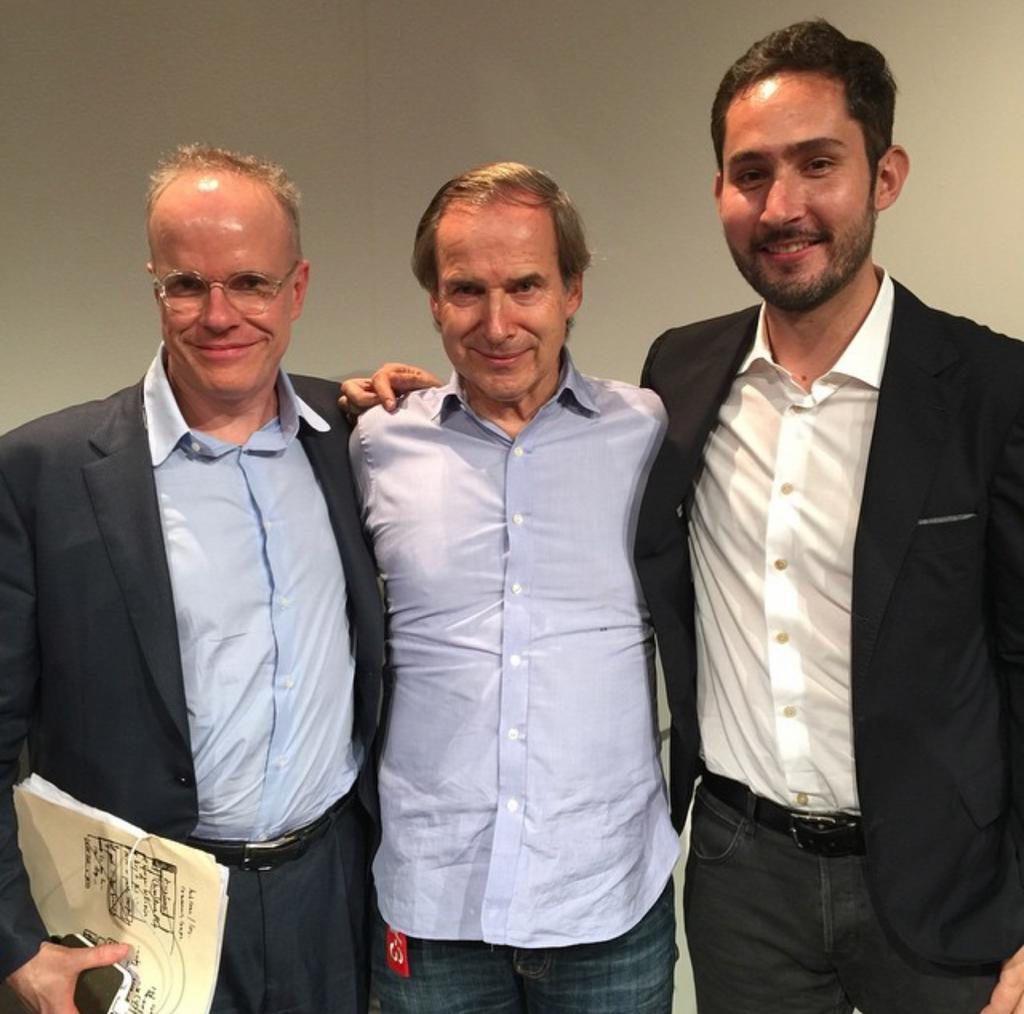The Hammer
Simon de Pury on How a Facebook Scam Has Shaken His Love for Social Media
The veteran auctioneer issues a warning about online fraud in the art world and beyond.

The veteran auctioneer issues a warning about online fraud in the art world and beyond.

Simon de Pury

Every month in The Hammer, art-industry veteran Simon de Pury lifts the curtain on his life as the ultimate art-world insider, his brushes with celebrity, and his invaluable insight into the inner workings of the art market.
It is two friends, whom I have loved and respected forever, Hans Ulrich Obrist and Jean Pigozzi, who were the first to introduce me to the joys of Instagram in November 2012. Social media platforms were already big back then, principally Twitter and Facebook. While I had marginally begun to use both of these platforms, none of them had a real hold on me. Quite the opposite happened with Instagram. I was instantly hooked on it as it was purely visual.
Suddenly everyone became an editor, a photographer, a publicist and an artist all at once. It was highly creative and for someone who already had the shortest imaginable attention span, it became an addictive platform. I began to follow artists, designers, photographers, musicians and filmmakers that I admired. One glance at anyone’s grid allowed you to understand in a nanosecond what made them tick. In July 2013 I wrote for the Daily Beast an article entitled “I’m Addicted to Instagram.”
In December 2014 Hans Ulrich Obrist and myself initiated a panel discussion during Art Basel Miami in which Instagram cofounder Kevin Systrom participated. We declared to a slightly bemused audience that Instagram was going to transform the art market.

Hans Ulrich Obrist, Simon de Pury, and Instagram founder Kevin Systrom at Art Basel Miami. Photo courtesy Simon de Pury.
As I am writing these lines, more than eleven years after having succumbed to its lure, my overall fascination with Instagram hasn’t really diminished. The platform itself has evolved considerably and the world around it has changed dramatically.
Instagram started online in April 2010. Its founders Kevin Systrom and Mike Krieger sold it just two years later for $1 billion to Facebook. This acquisition turned out to be one of Mark Zuckerberg’s various strokes of genius. Creating a billion dollar company in under two years is no small achievement, but with hindsight it is clear that Systrom and Krieger sold it far too early. It is a little bit like an art collector who had the flair to acquire a top work by Jean-Michel Basquiat back in the days when it cost $10,000, and unlike Ulysses was not able to resist the song of the sirens when they were offered $1 million for it.
While Facebook’s appeal rapidly diminished over the years, Instagram grew to become a global phenomenon. It adapted to the competition and offered the chance of getting in touch with any IG user directly through DM. When Snapchat looked for a while as if it could become a threat, Instagram rapidly adapted by offering the chance to post stories that, as on Snapchat, would delete after 24 hours, and a multiplicity of fun filters and ways to make the whole experience more entertaining. Then TikTok came and conquered the world by first monopolizing the attention of preteens and retaining it when they became teens. That is the time when I started participating in dance routines choreographed by my then 9-year-old youngest daughter. It was fun but didn’t manage to hook her old father. Each social platform is essentially a time thief, and I was already spending far too much time on Instagram.
The mother company of IG changed its name from Facebook to Meta and Instagram introduced some elements that made TikTok popular by pushing reels. From an art world perspective it is still Instagram which is by far the most interesting platform. I haven’t been reading art magazines for years now and the totality of emerging artists making it today have been discovered by galleries on the platform. It is therefore invaluable in following the practice of any artist, photographer, architect or ceramicist, to follow exhibitions or art fairs taking place anywhere in the world. I am still working hard at trying to be in at least two places at the same time and to be everywhere at once. Ubiquity keeps eluding me but Instagram helps greatly in the meantime.
More recently I have been personally confronted with a much darker and sinister side of social media. Earlier this year? Last year? An artist that was unknown to me sent me an angry WhatsApp message asking me why I had gone silent now that he had sent me money for me to include him in an exhibition project. I was puzzled and checked my past emails, text messages, WhatsApps, and Instagram DMs to see if I could find any past communication from him. I didn’t so I responded that I had never received any previous message and most certainly had never asked for any money.
Soon I received messages from other artists, that were equally unknown to me, that either had fallen into the same trap or, more luckily for them, wanted to check if it was really me who had asked for money before sending anything. They were all referring to an entirely fake Facebook account and sent copies of the text messages they had received from fake senders pretending to be me. I was highly perturbed by this identity theft and in particular by the fraudulent approach to steal money from unsuspecting artists on my behalf. These texts were written in a much more articulate way than I could ever have formulated myself. They claimed that I was planning an exhibition in collaboration with one Christine Aschwald.
First, I didn’t know if Christine was a fictitious name or if she really existed. I found out that while I haven’t had the pleasure of meeting her yet she very much exists and is a Senior Director at Artsy. The unsuspecting artists were getting enthusiastic feedback on their work not by one art market professional but by two equally unsuspecting ones! Once the artist responded to the bait he was sent what looks like an expertly done proposal presented in a graphically compelling way.
I have instantly informed Meta of what had happened and asked them to take ‘my’ fake Facebook account down. I asked all the artists who had been fraudulently approached to do the same. Here comes the most depressing aspect in all this: I received notice from Meta that they had looked into my request, had found no need to do anything about it and that the matter was now closed. At the time of writing this article my fake Facebook profile is still active.
If all this was an isolated incident it would be anecdotal and irrelevant for a multibillion dollar business like Meta. It very sadly isn’t and is in fact a scam that is omnipresent at Meta. I have come across many users who have faced similar issues not just in the art world but in any area. I recently saw an Instagram post of Björn Ulvaeus from the pop group behemoth Abba complaining about an identical situation. It makes companies like Meta hugely vulnerable and just as much as their success was meteoric, a proliferation of fraud and lack of trust as a result of it will get people to turn their back on them.
So far Meta does not seem to have recognized the danger and have not directed the necessary financial resources to address the infestation of Facebook and Instagram. You realize that for instance when some of the comments on your posts are hidden. When you unhide them you see that they have noting reprehensible in them and that the ‘hiding’ can only have been instigated by bots and definitely not by any humans.
Social media were meant to bring the world much closer. In many ways they have and I love the global connections that they have brought about. The flip side is that their abuse has fomented polarization, hate, bigotry, intolerance, theft and fraud. For the world to get a better place the main social media companies have to clean up their own houses first!
Simon de Pury is the founder of de PURY, former chairman and chief auctioneer of Phillips de Pury & Company, former Europe chairman and chief auctioneer of Sotheby’s, and former curator of the Thyssen-Bornemisza Collection. He is an auctioneer, curator, private dealer, art advisor, photographer, and DJ. Instagram: @simondepury